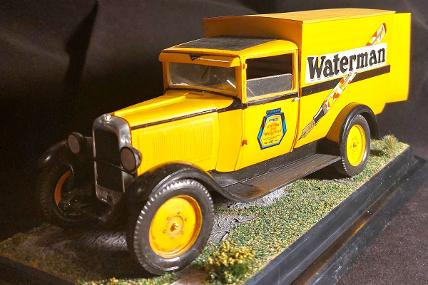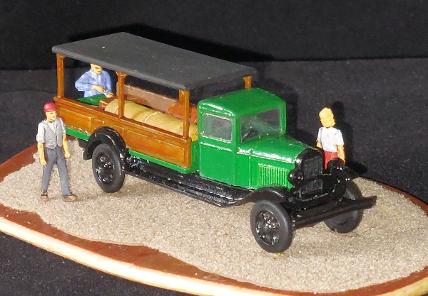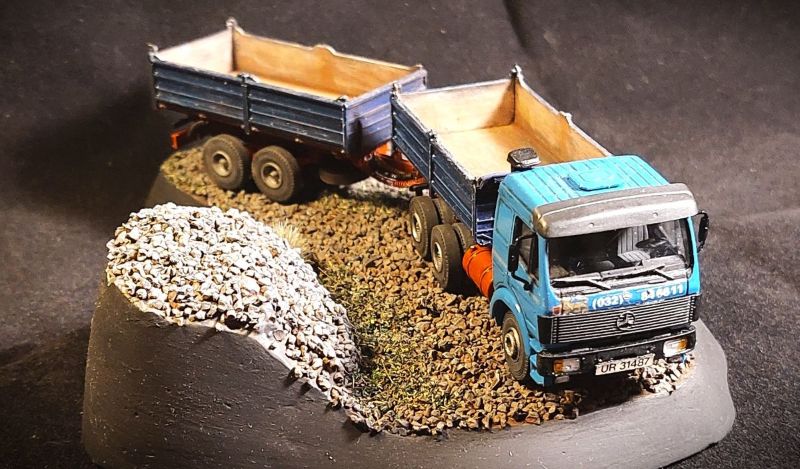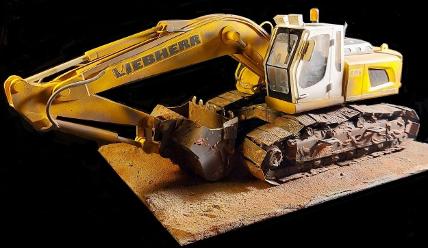The public transport
and commercial vehicle collection.
Since cars were really rather expensive the general populace went about their business as they had done so for centuries. Slowly the internal combustion engine took over from the horse and steam engine. While this took time so did the evolution of the body work styles, and lets be honest, most people are happiest with what appears familiar and safe.
The traditional methods of transport for goods and passengers had already undergone one revolution when the trains came thundering through the landscape.
While the horse could hold it’s own in the towns, and was affordable for small operations, it could not compete in the speed stakes against the train, nor could it carry as much.
Now the train was going to face its own threat for superiority, but it didn’t seem much of a threat at all for quite some time.
While steam powered cars competed closely with internal combustion engine vehicles in the early years of the car neither was fast enough, or reliable enough, to compete with the train, surely not?
Stage-coaches existed in the 17century, but many vehicles described as ‘coaches’ would have been covered stage-wagons carrying passengers and goods.
Standard pattern mail coach.
Ho scale Lifelike kit.
The landed gentry were only too willing to sell their land to the railway companies and extol the virtues of the steam engine, as long as it stayed off the roads. An unfortunate consequence was the roads were neglected and left to deteriorate. Goods travelled by Cannal and by Train, only the select few travelled very far anyway so nobody seemed too concerned at the state of the roads.
Stevenson’s rocket.
Ho scale Airfix kit.
William Hancock's steam coach "Enterprise".
1/24th scale scratch built model.
In 1833 Hancock's steam omnibus, the "Enterprise" (built for the London and Paddington Steam Carriage Company) began a regular service between London Wall and Paddington via Islington. It was the first regular steam carriage service, and was the first mechanically propelled vehicle specially designed for bus work to be operated.
Hansom Cabs.
Joseph Aloysius Hansom’s cab of 1833 was unlike the vehicle that made his name a household word. Huge 7’ 6” (2.3m) diameter wheels made the absence of springs relatively unobjectionable! Edward Bulnois modified the Hansom using smaller wheels on a cranked axle. A better cab was patented by John Chapman but his company was bought out by the owners of the original Hansom cab patent. Chapman’s cabs were in all essentials the ‘hansom’ cabs which survived for the next 70 years. Due to the publicity given to the Hansom patent later cabs were still called by Hansoms name instead of their designer’s name.
Motor cabs. Several manufacturers produced motor cabs but the first petrol cabs to ply for hire in London were Rationals, designed and built by Cockshoot & Co. Other firms such as Argyll, Belsize and Humber after building a few cabs found their car business in need of all the manufacturing space available and no cab company was prepared to place a large enough order to make cab production viable. One of the oddest vehicles came from Vauxhall; a 1904 two cylinder motor hansom with driver’s controls and seat out-rigged at the back of the roof. You shudder to think of the number of corners and connections the steering and other controls had to go round before performing their function. The design was suggested by the Earl of Ranfurley…..it never caught on….. and fortunately none ever plied for hire.
The model cab’s on display replicate a Forder built cab of c.1890 (Horse purchased from the Norfolk Shire Horse Centre) & a 1904 Vauxhall ‘Hansom’ mounted on a 1904 Vauxhall car chassis similar to the yellow 1905 Vauxhal shown here, all are scratch built to 1/24 scale.
As the industrial revolution brought more and more people into towns and cities, getting around the cities became more of a problem. Walking was time consuming and brought a certain degree of risk at various times of day. If you could aford a cab, all well and good but many people yearned for a lower cost system of travel. Harking back to the steam buses came horse drawn buses and later trams. Trams became horsless as electricity became more and more practical. At last there were reliable low cost travel systems moving workers and consumers around the towns and cities. And new job oppertunities for the drivers and mechanics and electricians too.
The Electric Tramway.
The first tramway in England was laid by George Francis Train, an American, who obtained permission to lay tracks from Wood Ferry to Birkenhead Park. The service started on 30th August 1860 with L-shaped rails that protruded ¾” (2cm) above the road surface, much to the annoyance of carriage and wagon owners; the track had to be re-laid with grooved rails.
By the late 1800s and early electrification of the tramways hit the horse bus even harder, especially with new transport organisations at borough council level stepping in. Although the petrol powered bus was just around the corner and would hit, now was the time of the tram.
E1 Class Tramcar.
Originally designed and built in 1907 in three basic series. The model is a Walthamstow/Croydon car built for their System and later merged with London Transport.
HO Scale Tower kit.
Union Construction Co. Feltham Tramcar. The London Metropolitan Electric Tramways began a series of experiments in 1929 and a year later introduced an experimental ‘Pay as you enter’ car, number 331, with central entrance and exit and known as ‘Cissie’.
HO Scale Tower kit.
Blackpool tram 706
Known as “Princess Alice” was amongst 27 built by English Electric from 1934 to 1937. 13 of which were the open top variety.
HO Scale Hadfields kit.
Just as the horse drawn coach and cabs gave way to electric tramways, so the horse drawn trolley bus also was superceded by the internal combustion engined omnibus. These transferes were not without there conflicts and problems but a brave new world of public transport could not be stopped. Little by Little the bus companies fought with the cabs and trams, and each other, for the rights to business in the towns and cities.
But more than that, the quick minded business men realised they could compete with the railways for trips to the seaside or into the countryside. The charabanc trip became a new social outing and before long these motor-coaches were also prividing links between towns and villages.
The 1911 B-type Motor Omnibus.
The London General was formed in 1856 by the purchase of several independent horse-bus concerns and the early steam and electric motor buses were based on the horse bus.
With the internal conbustion engine becoming a reliable item many other things were suddenly much improved. It was not only the Fire appliance that was moving under its own power that made fire fighting more effective, the centrifugal pumps became much better as the rpm rate of the internal combustion engines was much higher than that of the steam engines pumps.
1915 Dennis pump escape.
The Dennis chassis was used for a number of vehicle types, as was common at the time, but none is more evocative than the pump escape. With Zeppelin raids increasing London fire brigade needed the latest equipment, little did they know how much worse was to come just 25 years later.
Both models are 1/32nd scale Airfix kits.
During WW1 the internal combustion engine technology took huge leaps forward. Aeroplane engines gave ever greater power and engineers were learning all the time about carburation and valve opening over lap.
Trucks were used for transporting men, and all manner of materials, so by the end of the war not only were the machines themselves much improved and more reliable, people were used to them being around too.
Between the wars cars, buses and taxicabs all took the roads in ever increasing numbers but the old leveler of money still kept most people reliant on the bus.
Thornycroft listed their 4 ton ‘PB’ in October 1926. Especially designed for delivery work in towns, were space was restricted, it was designed with the cab virtually on top of the engine. This was termed the ‘forward-control’ chassis and allowed the ‘PB’ a bigger load area than the earlier ‘KB’ model despite being on the same wheelbase and almost the same overall.
HO-OO scale Peco kit.
1928 Citroen C4 Fourgonette van.
The Citroën C4 family car range was unveiled at the 1928 Paris motor show. Over the next four years around 120,000 C4 cars were produced across several passenger body styles and, once again, light utility versions.
The undoubted increase in power was a most important factor, along with proven reliability, and was soon inspiring a new range of commercial vehicles upon the C4 chassis. Citroën C4 range of pick-up or van models soon became a C4 and C6 range of Commercial vehicles, Taxis, fire appliances and more.
1/24th scale Heller kit.
1940 Fordson W.O.T.1/A1 Airfield crash tender.
The RAF and RN used these vehicles along side the older Crossley 6x4 Teardrop (of 1936/7) and the Crossley 6x4 (from 1939) which carried the same configuration as the later Crossley 4x4. During the Battle of Britain the Fordson Sussex 6x4 equipped with 3 x 30 gallon froth extinguishers, and the Fordson WOT1 were the most common fire tenders. The WOT1A/1 carried 400 gallons of water and 65 gallons of foam concentrate.
When the US Army Air Force came into Britain, sometimes completely taking over RAF bases, they took over the Firefighting equipment too. It was common to find USAAF personnel operating repainted RAF crash tenders throughout the war even alongside their own Dodge GMC based trucks..
1/72nd scale Airfix kit conversion.
1942 Dodge WC54 Ambulance.
Some 22,857 of the Dodge WC 54 3/4-ton ambulances were built and deployed in all theatres of war, with many of the Allied powers (thought notably not Russia). The Dodge model code WC is derived from W for 1941 (first year of production) and C for half-ton rating.
1/72nd scale Academy kit.
1942 Clarktor 6 MILL-44 Heavy Aircraft Tug.
Used across the American military forces for heavy towing jobs on airfields, Aircraft carriers and Quatermaster depots, the Clartor tugs proved their worth time and again. The Clark Equipment Co. built 3 models of the Clarktor tow tractor between 1940-1963, a "light duty" version, the heavy duty "Mill 44" and a heavy duty "Mill 50".
The smaller version was used for towing small and mid-sized aircraft, small to medium weight goods trains and ground support equipment for aircraft maintenance. The heavy versions took on the big loads and could move up to 90 tons on level ground.
1/72nd scale Academy kit.
1943 White M3 halftrack.
00-H0 Airfix kit conversion
Using the White scout car as a starting point and adding tracks the M2 halftrack artillery tractor came into being. This was in turn, was extended and became what was officially called the “Carrier, Personnel, Halftrack M3”.
The front end of the M3 halftrack has clear relationships to the M3A1 four-wheel-drive scout car but the tracked rear half is clearly different. Testing through 1939 proved the design and production started in 1940. As the tensions of the 1930s Europe had erupted into full blown war, and the U.S. itself was facing mounting tensions with Japan, the halftrack was going to be an important part of the new mechanised armies of the world.
Post WW2 many of these vehicles found new lives in the civilian world as cranes, fire appliances, water tankers and construction vehicles.
1951 Flxible Visicoach Intercity coach
In 1913, Hugo H. Young and Carl F. Dudte founded the Flexible Side Car Company in Loudonville, Ohio, to manufacture motorcycle sidecars with a flexible mounting to the motor cycle. The flexible mounting allowed the sidecar to lean on corners along with the motorcycle, and was based on a design patented by Young.
In 1919, the company dropped the first "E" in "flexible" changing its name to the Flxible Company as the business looked for new opportunities to expand.
American Precision Models (APM) 1/87th Scale kit
Routemaster bus.
The bus is part of the British heritage. People always remember the older "double decker" buses. This was something that faded out in through the 1980s and 1990s, many bus companys saw falling passenger levels and single deck coaches replaced the double deckers in almost all towns and cities.
Research found buses with a driver and conductor provide the most efficient service. Passengers do not have to wait to pay the driver, therefore getting on and off is much quicker and the bus is not kept standing at stops for long periods.
Routemaster style buses have made a comback in several cities recently, but then so have trams!
HO scale KielKraft kit.
Park Royal Diesel railcar
Park Royal Vehicles Ltd produced the Diesel Rail Car from 1958. Only five were built, three were used by Bedford area while the other two went to the Scotland. All of them had gone out of use by 1968. Sadly none of the vehicles exist today and the even the model kit is out of production.
HO scale Airfix kit.
The transport trucks of the first world world war proved that logistics was more than just the railways themselves. Although the railways were capable of transporting huge volumes of cargo over long distances they were still reliant on rails!. Getting goods from the rail head to the consumers still needed horses and cart or trucks.
These internal combustion engined trunks also proved they were a viable alternative to carts and to trains and after the war entrepreneurial minds bought up surplus vehicles and started local haulage firms in the towns and cities. As these companies proved their worth so more specialised vehicles arrived on the scene.
In the United States these same lessons were being learned due to the expanse of the Country, and vehicle manufacuteres were quick to pick up on the needs of businesses across the continent.
From huge articulated trucks covering city to city trips, to small vans for local deleveries and small tradesmen, commercial vehicles had arrived.
International Auto wagon 1910 high Wheeler.
International Auto Wagon was “designed for use in cities, country towns and rural purposes where a light commercial car is desired”. Allowing “quick deliveries, ...thus enabling....better service and serve more customers......it will do as much work as two rigs, thus saving the cost of one driver as well as the expense connected with care of extra horses”. “The lightness of the International auto wagon and its facilities for short turning make this car most acceptable for use in narrow streets and alleys....” and “there is no reason why it cannot be used as a pleasure vehicle when occasion demands. It has the same easy riding quality as the auto buggy
ZIS 3HC-5 3tonne truck.
ZIS-5 has its origins in the AMO (Automobile Moscow Obshchestvo) company which began to produce trucks in 1931. Running through the AMO-2, AMO-3 and AMO-4 series before the company was renamed in 1933 as ZIS (Zavod imeni Stalina). Production of the Zis-5 started in late 1933 and along with the GAZ-AA became the mainstay of trucking in the Soviet Union during the ‘30s, ‘40s and ‘50s. The Zis-5 continued to form the basis of development for many specialised vehicles even later than that.
1/76th scale Eastern express kit.
Vickers-Armstrong Universal Carrier
The Universal Carrier is the most produced armoured fighting vehicle of all time. 113,000 were built between 1934 and 1960, in Britain, Canada and the Antipodes. In post war Australia they were modified to make up for a shortage of agricultural tractors and in Canada one was sent to Sable Island to tow life boats up and down thw 44km sand bar.
Truly a universal vehicle.
Coles crane on Thornycroft chassis.
The Coles EMA MKVII crane was a state of the art piece of Electromechanical engineering in the late 1930s and with WWII looming thousands were ordered for the R.A.F. for recovery of 'downed' aircraft.
Available as a trailer version or mounted on an automotive chassis the crane saw action all around the world.
Post war many of the combo's were sold off as war surplus and led long lives in the hands of large haulage firms and small privateer outfits alike.
1/72nd scale Airfix kit conversion.
Austin K2 Fire tender
Austin received a state order forcing them to return to the production trucks in January 1939, the British government probably foreseeing the war to come.
Austin’s new range, later called “series one”, comprised of two versions initially, the 2 tonne capacity K2 and the 3 tonne K3.
Most famously seen as the ambulance version and staring in the film "Ice cold in Alex" the K2 chassis was used extensively for ambulances, fire tenders, vans and light trucks.
1/72nd scale Airfix conversion.
The Morris ‘J’ type van
...was introduced at the 1948 Commercial Motor Show at Earls Court. Production followed in the autumn of 1949. It has been used for many different commercial roles from Royal mail and “Meccano” delivery vehicle to ice cream van.
There is a thriving owners club in the UK and so many memorabilia items it’s almost as popular Ferrari!
N gauge Classic model company kit.
Austin FX4 Taxi.
Called the most beautiful taxicab in the world, the FX4 stayed with the classic tall boxy profile that has its origins in a horse drawn carriage more than three centuries before. Officially designated standard taxicab by H.M. Government in 1958 it has almost the same styling as the FX3, which preceded it by 21 years. Turning circle 12ft.6ins (3.8m), seating for 5 and tall enough to let a passenger with a bowler hat enter without taking it off!
How taxi cabs have changed over 60 years of developement. A further 50 years on and London taxi cabs still look very similar today!
1/24th scale Imai kit.

Cyrus Hall McCormick patented his horse-drawn reaper in 1834 and started McCormick Harvesting Machine Company with his brother in Chicago around 1847.
His company did rather well over the years and trucks became a mainstay of the company.
In 1986, IH was renamed Navistar International Corporation and focused on heavy duty diesel trucking. However Navistar struggled financially for some time.
The S-Series was Internationals medium-duty truck line from 1978 to 1992 replacing the Loadstar. Like the Loadstar, S-Series trucks were commonly used for local delivery trucks and school buses. It also provided the basis for the F2575 tractor unit which was widely used across North America for haulage purposes.
Model F2575s were usually powered by 300hp Cummins Turbo Diesel engines, but have also been seen with 350hp Caterpillar units. Gearing was through Fuller 9 speed transmission with the option of automatic units available.
1/25th ERTL kit.
Fork lift
Although this type of work horse has been around for many decades now current "Health and Safety" law has made them more than common place.
Fork lifts have evolved down many routes becoming battery powered carts moved by small wheels, lightweight units capable of being carried as part of a delivery truck system or full on warehouse movers much bigger than the one that is part of our museum.
1/24th S.E.L. kit.
Ford C-series 800 truck.
Fords C-Series was a medium-duty cab over truck built in several series between 1957 and 1990. It was primarily for local delivery and fire appliances in the U.S. proving very versatile
In Canada, the Ford "C" had an identical twin - the Mercury "M" Series offered from 1957 to 1972.
Many truck makers used the Ford C-Series cab for vehicles as diverse as large airport crash trucks as well as cab-overs, tippers, bulk liquid tankers even vacuum street cleaning trucks.
In our collection the C-800 cab-over has been converted for an F1 team transporter of 1977. A far cry from today’s F1 back up services but a clear sign of the new ultra professional image conscious age that was coming.
1/32nd scale Entex kit.
1979 Ford "Transit" van MkII
The Transit was a modern marvel, a huge step forward from the Ford Thames van it replaced and the Commer and Bedford CA vans it was competing against. It’s flexibility, comfort and ease of use were such a revelation the Transit was an immediate success and soon a familiar sight on British roads and became a byword for all light commercial vans.
Today there is hardly a company in Britain that hasn’t used a Transit based vehicle. A cargo van in short and long wheel base, a minibus, cutaway van chassis, a drop-side pickup truck, recovery vehicles, food vendors, the list of Transit chassis applications is huge making it a bedrock of local commerce and allowing Ford to Market the van as “the backbone of Britain”.
Mercedes-Benz's flagship 6x4 2238 S was just what was needed exactly when it was needed. A long-range heavy-duty truck with the OM422 375hp engine that would set new standards in drive-ability and driver comfort. From roomy cabs and bunks to smooth gearchanges, the 2238 S was a huge upgrade over the British trucks of the era.
But after being on the roads from 1973 to 1996 the design eventual reached the end of it's development room and the SK series was replaced by the new heavy-duty Mercedes-Benz “Actros”. This truck took ergonomics in the the cab, and economics in the engine bay, to new levels. Once again, Mercedes had taken a leap in the future that left other European trucks contemplating how they were going to respond.
1995 Mercedes-Benz SK2544 chassis Meiller-Kipper tipper and Müller-Mitteltal tipper trailer.
The “SK” of the Mercedes-Benz SK series stands simply for Schwere Klasse "heavy class". That is to say Lorry models with a curb weight between 10,000–26,000kg. While Mercedes-Benz trucks were doing good business the world was beginning to wake up to the ecological dangers of fossil fuels and move towards countering expected laws from the increasingly lobbied political arenas of Europe. Mercedes needed to respond as much as anyone else and worked on upgrading their rigid trucks.
The SK series started as a reworking of the NG chassis with a better cab over the OM44X series engines, themselves and evolution out of the OM42X unit. New and advanced electronic driver aides and fault diagnosis were innovative the driver comforts meeting the highest of standards.
2009 Liebherr R916 excavator
Hans Liebherr founded his firm in 1949, in Kirchdorf, Württemberg-Hohenzollern, in the then West Germany. Post war Germany was desperate for reconstruction equipment, so much of it having sustained heavy war damage. A crane that could move would speed things up and Hans Liebherr, alongside a team of design engineers and tradesmen came up with the TK 10. The worlds first mobile tower crane.
Diversification has played a big part on Liebherr's success. Versatility, reliability, innovation and strength are also words that describe not only the products they make but the company as a whole. Despite the years seeing change in the board as the family has aged, the Liebherr family remain firmly in control, building
“Big machines for big tasks.”
There are more commercial vehicles to be added to the museum, come back again to see what new vans, lorries, cranes and 'cabs make it through to these pages.



















